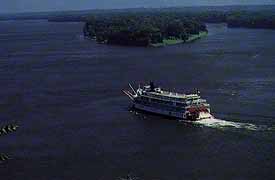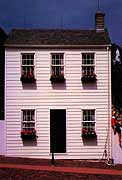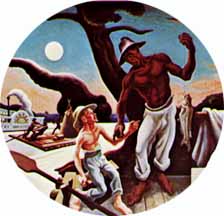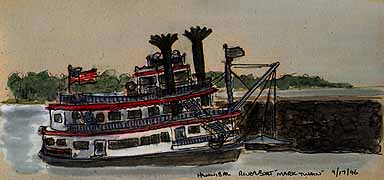American Sabbatical 015: 9/17/96
Hannibal
9/17.. Across the river.
Then we tried to get out of Illinois. I mean, we didn’t think we’d spend 8 days in Illinois! But it
had a grip on us. We were going to sprint to the Mississippi,
then start our questing. But the East had a grip on our wheels,
and dodge as we might, we just couldn’t get across the great water.
Trying to avoid interstates after Cahokia..how could we plunge
back into that?...we found ourselves back in bucolic corn country,
like a returning nightmare. The river kept turning away from us.
We spilled out into the Illinois River valley, classic flatsyourpalm
blackdirt turf, but there was no getting across IT, either. Finally,
just as the sun burned down through the gray and the weather cleared,
we romped up onto the high ground across from Hannibal. Instantly
we were in the middle of Huckleberry Finn. There was The Island, and the Mythic River, just as you imagined
them. And a paddlewheeler just putting into St. Petersburg. Sure
it’s all tourist town makebelieve, but it sure looks like Mark
Twain, and wouldn’t he get a yuk? Now we’re camped at the mouth
of Tom’s cave (which Peggy will not go in), and ready for a day
of mythologizing. Maybe even e-mailing.

Watercolor by Karl Bodmer 1832
(Memo #14)
Sept. 17 - FICTIONAL HISTORY - Hannibal, Mo. & Riverview, Ia.
Who? Samuel Clemens (Mark Twain)
What? His hometown and the source of setting and characters for
his novels
Where? a small town on the Mississippi in Missouri
When? mid 1800s
How? father had a business there
Topics: Mark Twain, Huck Finn, Tom Sawyer, fiction and history
Questions: When an author captures a place in a famous book, does
it change the place?
|

Huck's Island
(postcard)
|
You can learn a lot about Mark Twain in Hannibal, Missouri. You
learn more about Hannibal, Missouri, and the process by which
history becomes fiction and fiction becomes history.
People come to Hannibal to see the source of Huckleberry Finn
and Tom Sawyer where the author - as the boy Sam Clemens - lived.
The Clemens family moved here from the boy’s birthplace in Florida,
Missouri. His father was a judge and storekeeper in the town.
The Clemens house, the law office, the apartment over the drugstore
where the family lived when financial difficulties caused them
to lose their house (all in the downtown area) are all preserved.
In fact, the whole two-block area of downtown has been basically
cordoned off. You enter a museum and follow a carefully orchestrated
tour across a memorial garden up to the second floor of the house,
down to the first floor, into the museum store, across the street
to the law office, upstairs to the apartment over the drugstore
and then downstairs to the drugstore.

Tom's house
(Peggy picture)
|
You do get a sense of the town’s geography. The town is set on
the Mississippi, here a slowmoving river about the size of the
stretch of the Kennebec River I know in Maine. High bluffs are
found just north and just south of the town which is really in
a valley. Several lowlying islands lie across the river from the
town shore. There is an oldfashioned riverboat moored at the landing.
Many of the two story brick stores remain from Twain’s era (though
now painted in pastels). Just standing in town, you can imagine
the longings of a restive young boy to be off down the river,
over to the islands, up on the bluffs. |
Norman Rockwell, before illustrating Twain’s books, visited the
town. Afraid he might not find enough, he was astounded. “Mark
Twain had swallowed up Hannibal,” he noted. He’s right. Every
store has a Twain title: “Becky Thatcher’s Bookshop”, “Aunt Polly’s
Restaurant”.
What is scarier are the markers you see throughout town. “Here
is where Huck..”, “Here Tom Sawyer..” signs read in the same print
used for a historic site marker such as “In 1846 Bill X built
a store here in which he sold dry goods.” After a time, you realize
that Tom and Huck and Becky and Aunt Polly are being treated as
historical personages. Well, they all WERE patterned on real people
(Aunt Polly is Twain’s mother, for example), but the line between
history and fiction is blurred and apparently was even to the
people themselves. The museum has a copy of an interview done
with Twain’s boyhood sweetheart Laura Hawkins that begins, “ I
am Becky Thatcher."
I can imagine the difficulty of touring Hannibal with a child.
No, Huck wasn’t a real boy, but Sam Clemens (who was really Mark
twain) knew someone LIKE Huck and the hill in the book is really
this hill.
| The bizarre feeling I got of history as fiction and fiction as
history was heightened by the museum exhibits. Wonderful bits
of Twain memorabilia - one of his white coats, his harmonium,
several of his pipes, photos of him writing, pictures of his wife
and daughters, were interspersed with odd bits of things gilded
by sortofmaybe association with a great man. A cape worn by someone
at the time, a newspaper clipping PROBABLY set by Twain when he
worked as printer’s apprentice, silver owned by someone who lived
in Florida, Missouri AT THE SAME TIME as the Clemens family, an
old bicycle LIKE the one Twain described. |

Thomas Hart Benton's Version
|
In the house and law office fictional sets are provided behind
glass panels. You stand in the entry and press a button and get
told that this was the Clemens parlor PROBABLY used by Mrs. Clemens
for entertaining and the furniture is AUTHENTIC TO THE TIME PERIOD,
and at this door Aunt Polly stood.... . (Fiction and history,
history and fiction... I wonder if empty rooms might not have
served better. When I visited the Ann Frank secret annex in Amsterdam
the whole place was empty and it was incredibly powerful.)
I came away bemused. Twain has swallowed Hannibal, but Hannibal
is alive and well. Few small towns hereabouts are. We spent a
week in Illinois, driving from Chicago down to the Shawnee National
Forest at the southeastern corner, following the Ohio down to
Cairo and the Mississippi up to Hannibal. We went through a hundred
towns and villages that seemed dead or dying. Boarded up stores,
decaying houses, empty lots everywhere. Hannibal survived because
of Mark Twain. Isn’t that in fact what the books accomplished,
to make a town and an era live forever?
We drove on from Hannibal toward Cedar Rapids and came by chance
on the ultimate fiction as history. Our guidebook clearly labeled
Riverview, Iowa, as “The authentic future birthplace of Captain
James Kirk." Of course, we had to visit. We drove into the small
town... no signs except in the town square. Parked right on the
grass was a trailer with a float for a parade. It was a small
scale model of the Starship Enterprise (clearly labeled as such)
with the yearly date of the parade lauding Kirk, and the claim,
again, of Riverview as ”The Future Authentic Birthplace of Captain
James Kirk." With thousand of Trekkies around, Riverview - like
Hannibal - has a future. There is a lesson in this for small towns,
and we saw it in Metropolis, Illinois (“Home of Superman”) with
a huge statue in the central square. Chester, Illinois, is now
the “Home of Popeye” with signs leading to the statue and a Popeye
museum. Well, a small Maine town has created Chester Greenwood
Day. Lisbon Falls has Moxie. BUT what about creating a new character
to save a specific town!!

Starship
9/17... To Cedar Rapids.
We are leaping across the map after escaping Illinois. Huck and Jim couldn’t find Cairo in
the fog, and we couldn’t seem to get across the river to St. Petersburg.
Once over the water, though, look out far West ..here we come.
It was cold and drear when we got up at Tom Sawyer’s cave (6AM),
and a nasty north wind was kicking up a small chop on the river.
We made a quick visit to lovers’ leap (hours: 6AM to 10PM ..no
unrequition after 10), then I hunched over my sketchbook on the
levee doing one of the paddlewheeler “Mark Twain". It felt like
a May morning on the Kennebec. In fact the Mississippi at Hannibal
looks a lot like the Kennebec in Bath, hardly the Mother of Waters
you’d expect.

Mark Twain (Bryce)
One of the old journals I read, written by some Italian count
in the 1820’s, followed his journey to the source of the big M
(he claimed prior discovery of the REAL source). The accompanying
map was fascinating. From St. Louis north into Wisconsin the place
and river names were in French. Then they were both French and
Native American. Finally up in the Lake of the Woods and the Lake
Superior watersheds the names were just in Indian. And you could
see the tribal territories. The endings (meaning “river” I assume)
were clustered in distinct areas (and followed the Count’s different
tribal contacts reported in the text). Sioux to the west, Saux
and Fox to the east. The uppermost “sippi” on the river was the
Missis-sippi. I’d always thought that was supposed to mean the
“Mother of Rivers”.. sort of a Iroquois linguistic thing. But
maybe it just means “the brook that comes out of fox pond”, or
whatever, and since that was the branch the early French travelers
portaged to from Superior, that became the name for the whole
river. A gazetteer of Native place names would be instructive.
As would a rivers-only atlas, and a hills-only one. Contemporary
road atlases just don’t show the landscape, and the historic landscape
disappears entirely. I meant to Xerox all the old river maps out
of the journals before we left but.....
While Peggy was nosing about in the Huckleberry Twain Museum and
other mythic shoppes in Hannibal, I was thawing out over the powerbook,
resurrecting lost mail. Seth had come through, and our car registration
was waiting at general delivery, Hannibal (and I gathered that
such mail was an unfamiliar item at the PO). Hurray for the kid.
So now I hoped to get us back on the E-train. But where to send
e-mail? Peggy suggested the local paper. You old newshounds will
be glad to know that the Hannibal Courier-Post will befriend male
modems in need of female outlets..or is that inlets? Not that
the reporters could make any decisions, but the production manager
was willing to let me play, if he could watch. Made me feel like
a masternerd. Ah the bouquets we carry. Or is that cachets? Ah
hell, I got all puffed up.
Then we were off for Iowa. Peggy had listed Nauvoo as a stop,
but that’s in Illinois, and I said NO more. This means that the
Mormons are getting short shrift this trip (isn’t that the kind
of underwear....?). We didn’t stop for the angel Moroni, now no
Nauvoo, and we think Utah is off our map, too. What’s going on
here? If Mormonism is The One Native Christian Religion, aren’t
we missing the story? Maybe we’ll repent and go tiptoe to the
salt lake.
Back into the lineated vegetables. Corn, soy, and more corn. But
also lots more fallow land, and hay and alfalfa mixed in with
the beans and CORN. We discovered that the strange-looking bottomland
crop (with a short stalk and leaves like corn but a heavy head
of seeds like some marsh plant) is milo .. makes sorgum. There
was lots of that in the river bottoms in Illinois, but back up
on the uplands it was CORN. Do I repeat?
But as Missouri turned to Iowa some ineffable transformation moved
in the air. The land looked healthier, the towns more solid (or
is it stolid?). Illinois seems worked to death, even in the heavy-producing
central sections. Was it just the temperature and humidity? Iowa
is a glorious corn-fed heifer while Ill. is an old milk cow on
steroids. Then there is the shape of the land. Grant Wood got
it right: the crazy-quilt angles, the full forms, the hard-edged
light. We think of Grant taking personal liberties with his landscapes,
until we travel Iowa. He got it just right. We kept coming over
rises and saying “O yes, there’s another Wood.”
A lot more trees, too. After a couple of weeks of flatness, Iowa
is like lolling in mother’s arms. If she’s running across the
freeway. There aren’t any byways. They didn’t build new highways
in IA., they widened the old ones. To get from here to there you
have to take the highroad. And the semis keep you rushing right
along. The tailgate stickers read “Truckers Carry America.” It’s
true, of course, and somehow the sight of big rigs looming up
over the rolling groundwaves make truckers the prime movers of
the landscape. You almost never see a farmer at work in the fields,
for instance. But the big rigs just move on.
History seemed a bit sparse in SE Iowa, although I could easily
imagine blooded Iowas galloping over the rolling fallow fields.
But Peggy is irrepressible. Right there in one travel atlas she
found a must-see entry. Here’s a chance for you to peep in Festiva’s
windows. We’ve taken on roles. Bryce is in the pilot’s seat, dodging
semis, while Peggy is nested in as navigator, balancing maps,
guidebooks, history texts, and other found objects. She calls
out the numbers. Next turn, take a left on 147 for Riverview,
about 2 miles. And glosses the directions with readings from the
lit. Riverview is “The Official Future Birthplace of Capt. Kirk.
Has an annual festival.” Only in America can a town create a fictional
history, and get the world to come. In high chuckle we moved on
into Cedar Rapids where I’ll let this fall down and go to sleep.

Bodmer 1832






